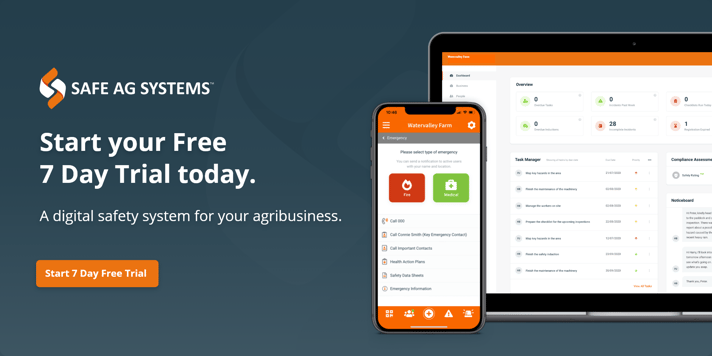You’ve landed on this article because you’ve asked the question “why do I need a safety management system?” As an agribusiness you potentially use an array of software to help manage day to day tasks including payroll, livestock, and crop management, even bookkeeping. Why should your safety management be any different?
What is it?
A safety management system is a planned, structured approach to managing health and safety in your business. It should ensure you manage risks in your business and as a result, provide you with a level of protection against potential penalties and prosecution. It can also provide additional benefits for your agribusiness. A safety management system should strive towards compliance with Workplace Health and Safety (WHS) / Occupational Health and Safety (OHS) legislation.
Using safety software to implement your safety management system is the smart way to achieve this. It puts safety at the forefront of tasks and activities on farm.
Why is it important?
Unless you have a dedicated health and safety person on-hand it can be hard to identify what your system should look like if you are just starting out. How do businesses know what records to keep or what documents they need? Implementing safety software should provide some guidance regarding policies, safe work procedures, risk management and other aspects based on industry standards, regulations, and legislation.
As we’ve mentioned, implementing a safety management system on your farm can produce roll on, positive effects for the rest of your agribusiness. You could gain a reputation as a responsible employer, reduce employee churn and increase satisfaction, resulting in higher productivity. This outcome could lead to attracting more business and increasing your competitive advantage. There are many financial reasons as well as environmental reasons to get started with a safety management system.

5 Benefits of safety software
1. Improved health and safety performance
A well thought out safety software allows for clear communication between an employer and their workers. It identifies policies and procedures that outline expectations and processes whether that be utilising machinery, equipment, or tools whilst at work.
As part of your management strategy ensuring farm workers understand how to complete their tasks in a safe manner should be a priority. Having safety software can also provide your management team with an overview of the health and safety of your business. They can identify policies read, procedures completed and checklists followed this could lead to recognising areas for improvement and actions to be taken.
2. Reduction in costs and lower insurance premiums
When it comes to running a business in general, mistakes are expensive, and consequences of those actions can be costly to rectify. If you haven’t implemented a way to track near misses or incidents, how can you identify improvements to reduce the risk and minimise exposure?
Without a safety management system, you are vulnerable to a range of financial costs including compensation claims, penalties issued by your safety regulator, medical and legal expenses which all have a flow on affect to your insurance premiums. If you can reduce the chance of an injury from occurring in the first place, you can lower the cost of the fall out. You can read more on health and safety potentially reducing workers compensation premiums here.
An injury to one of your workers can result in the loss of experienced labour. It can be an expensive exercise to train temporary or new staff to help cover the workload, and it can also negatively affect morale in the workplace. Costs of an injury aren’t always a direct financial impact.
3. Worker motivation and higher productivity
Utilising the data from your safety software to make improvement can result in fewer injuries and illnesses. When you get serious about health and safety, your workers will too. Feeling heard is important. When you promote a positive safety culture, worker motivation and productivity will improve, subsequently increasing your worker retention rate.

4. Increased regulatory compliance
When you incorporate a safety management system in day-to-day operations, you should have the peace of mind that you are providing the safest workplace you can for your workers. If your safety software follows industry standards, you are not only managing your responsibilities as an employer, but you are assisting your workers with their WHS obligations too.
Knowing you are doing the right thing doesn't necessarily prove you are, your safety software is also your record keeping tool. Having evidence protects your business as well as its reputation. Did you know consumers have been shown to favour businesses that strive for compliance and accredited businesses? Proving compliance and gaining accreditations can also positively influence your ability to obtain finance. Data collected in your system can be used as evidence for potential investors and banks.
5.Corporate and Social Responsibility
As we mentioned above, Consumers tend to favour compliant businesses, corporate and social responsibility (CSR) is a part of this. CSR is practiced by agribusinesses when they are conscious of the impacts their actions have on society, including economic, social and environmental.
As consumers become savvier regarding social and environmental impacts, adopting a reputable safety software program connects your business practices with a positive brand image.
It ensures that you do not partake in harmful labour practices and that you take your workers physical, social, and mental wellbeing seriously.
Whilst implementing a safety management system and software can seem overwhelming in the beginning and the motto of “that’s the way we’ve always done it” ringing in our ears, incorporating health and safety in your daily workplace management is a worthwhile investment. Following industry standards, regulations and legislation ensures you are doing everything in your power to become compliant, it protects your workers, and in turn your agribusiness, if that fateful day ever comes.
Topics: Safety Management System
Disclaimer: Content on this website may be of relevance to users outside of Australia, but content links and examples are specific to Australia. Please check with your local authority for your country and industry requirements.











